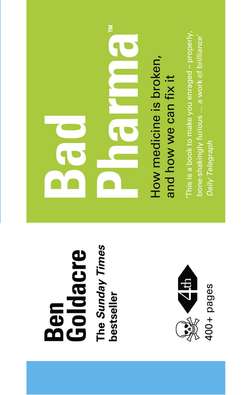Bad Pharma: How Medicine is Broken, And How We Can Fix It

Реклама. ООО «ЛитРес», ИНН: 7719571260.
Оглавление
Ben Goldacre. Bad Pharma: How Medicine is Broken, And How We Can Fix It
Copyright
Dedication
INTRO
What’s coming
How to read this book
1. Missing Data. Sponsors get the answer they want
Why missing data matters
Why we summarise data
How much data is missing?
Why do negative trials disappear?
How ethics committees and universities have failed us
What can be done?
How regulators and journals have failed us
Registers
What can be done?
Blood from a stone: trying to get data from regulators
Where are we so far?
What to do about all this?
Trying to get trial data from drug companies: the story of Tamiflu
What can be done?
2. Where Do New Drugs Come From? Where do drugs come from?
From laboratory to pill
Early trials
Phase 2 and 3
‘CROs’ and trials around the world
3. Bad Regulators. Getting your drug approved
Pressures on regulators
Approving a drug
‘Better than nothing’
Surrogate outcomes
Accelerated approval
Midodrine
The impact on innovation
Comparative effectiveness research
Monitoring side effects
Solutions
4. Bad Trials
Outright fraud
Test your treatment in freakishly perfect ‘ideal’ patients
Test your drug against something rubbish
Trials that are too short
Trials that stop early
Trials that stop late
Trials that are too small
Trials that measure uninformative outcomes
Trials that bundle their outcomes together in odd ways
Trials that ignore drop-outs
Trials that change their main outcome after they’ve finished
Dodgy subgroup analyses
Dodgy subgroups of trials, rather than patients
‘Seeding Trials’
Pretend it’s all positive regardless
5. Bigger, Simpler Trials
6. Marketing
Pharma’s medical school
CONCLUSION: BETTER DATA
Clearing the decks
Things you can do
AFTERWORD: WHAT HAPPENED NEXT?
The AllTrials Campaign
FOOTNOTES. 1. Missing Data
3. Bad Regulators
6. Marketing
Afterword: What Happened Next?
NOTES
GLOSSARY
ACKNOWLEDGEMENTS, FURTHER READING AND A NOTE ON ERRORS
By the Same Author
About the Author
About the Publisher
Отрывок из книги
To whom it may concern
Title Page
.....
In 2004 the International Committee of Medical Journal Editors (ICMJE) – a collection of editors from the most influential journals in the world – published a policy statement, announcing that none of them would publish any clinical trials after 2005, unless they had been properly registered before they began.62 They did this, essentially, to force the hand of the industry and researchers: if a trial has a positive result, then people desperately want to publish it in the most prestigious journal they can find. Although they had no legal force, the journal editors did have the thing that companies and researchers wanted most: the chance of a major journal publication. By insisting on pre-registration, they were doing what they could to force researchers and industry sponsors to register all trials. Everyone rejoiced: the problem had been fixed.
If you think it seems odd – and perhaps unrealistic – that fixing this crucial flaw in the information architecture of a $700 billion industry should be left to an informal gathering of a few academic editors, with no legislative power, then you’d be right. Although everybody began to talk as if publication bias was a thing of the past, in reality it was continuing just as before, because the journal editors simply ignored their own threats and promises. Later (pp.247, 307) we will see the phenomenal financial inducements on offer to editors for publishing positive industry papers, which can extend to millions of dollars in reprint and advertising revenue. But first we should look at what they actually did after their solemn promise in 2005.
.....